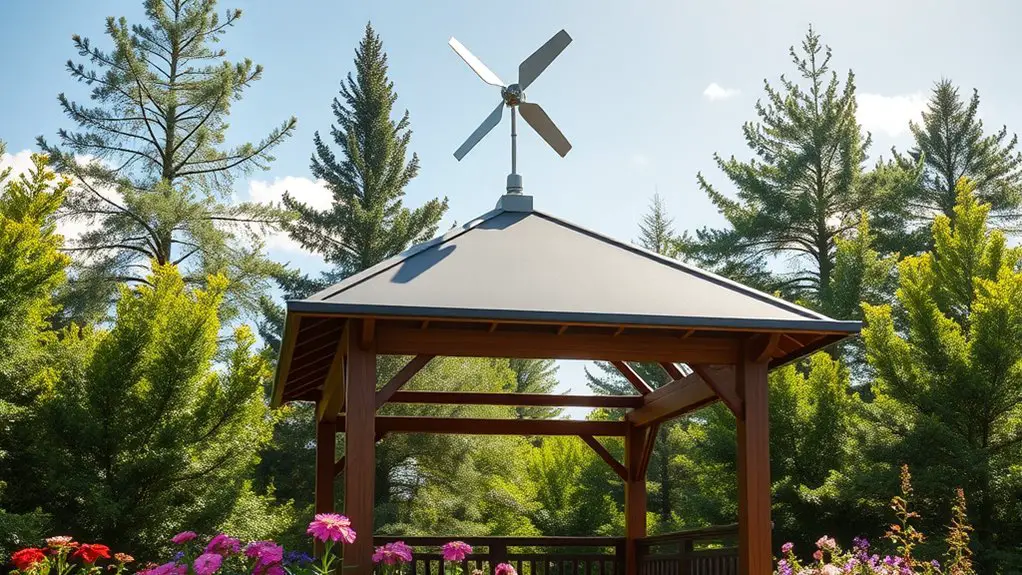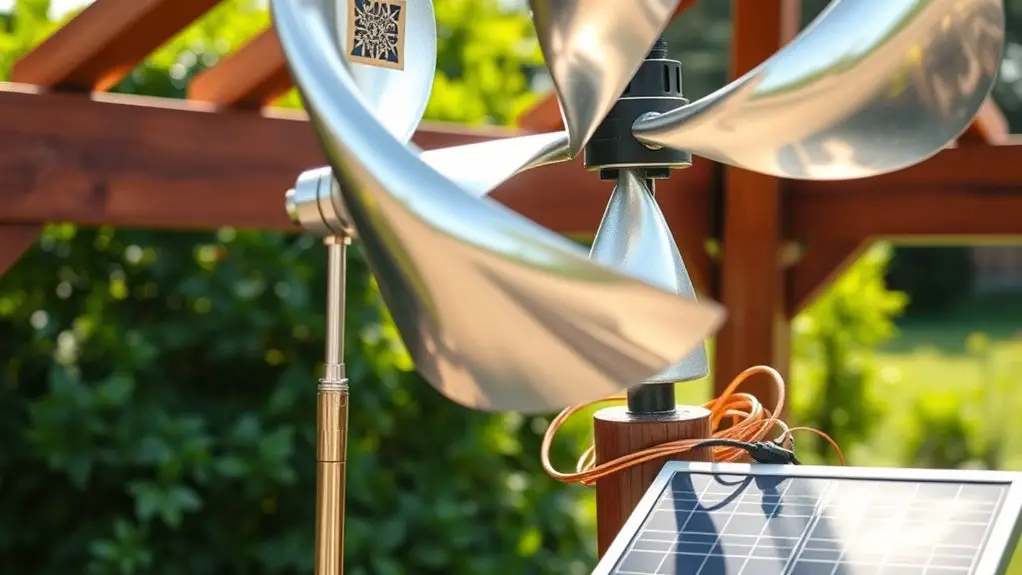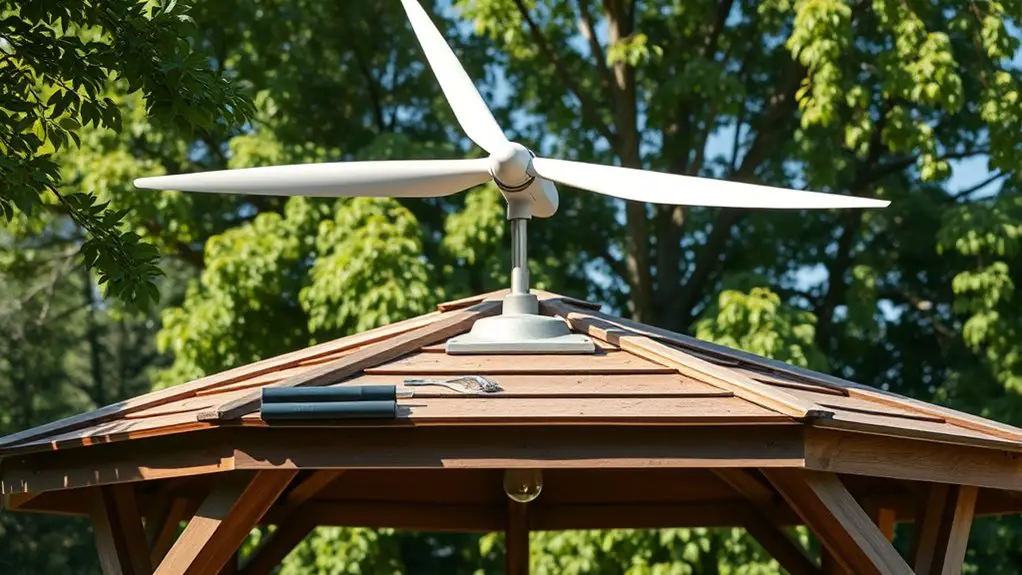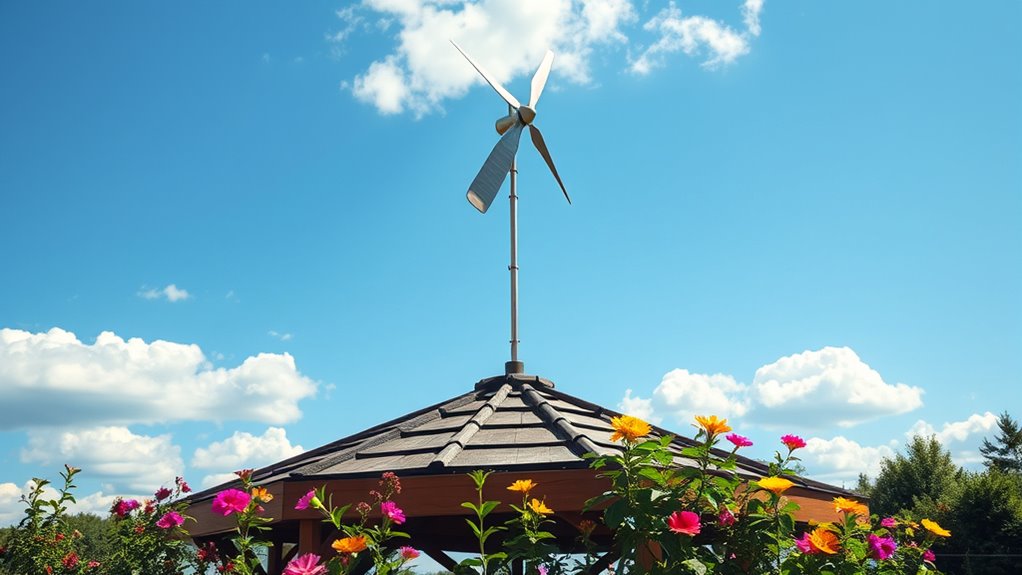Installing a DIY wind turbine for your gazebo can boost energy efficiency and lower utility bills. You’ll need to choose a location that’s at least 30 feet high and free from obstructions. Gather essential materials like a permanent magnet generator, lightweight blades, and quality wiring. Follow a step-by-step assembly guide to secure components. For peak performance, guarantee proper turbine alignment and conduct regular maintenance. Keep exploring to discover tips on assembly and troubleshooting for your wind turbine.
Benefits of Using a Wind Turbine for Your Gazebo

If you’re looking to enhance your gazebo’s energy efficiency, installing a wind turbine can be a smart choice. Utilizing wind energy not only provides a renewable power source but also leads to significant cost savings on your utility bills. By generating your own electricity, you’re less reliant on local energy providers, allowing you more freedom in managing your energy consumption.
Moreover, the environmental impact of harnessing wind energy is substantial. It reduces your carbon footprint and decreases reliance on fossil fuels, contributing to a more sustainable lifestyle. Wind turbines can also add value to your property, appealing to environmentally conscious buyers if you ever decide to sell.
Choosing the Right Location for Your Wind Turbine
When selecting a location for your wind turbine, it’s important to take into account factors that influence its efficiency and output. First, consider the turbine height; placing your turbine at a higher elevation can help capture stronger winds, which greatly boosts energy production. Ideally, you want your turbine to be at least 30 feet above the ground, free from obstructions like trees and buildings.
Next, observe the prevailing wind direction in your area. Positioning your turbine so it faces the dominant wind flow will maximize its performance. If you can, conduct a wind survey over several months to better understand wind patterns.
Lastly, verify the site is accessible for maintenance and that local regulations permit turbine installation. By carefully choosing the right location, you’ll enhance your wind turbine’s efficiency, ultimately leading to a more sustainable power source for your gazebo.
Essential Materials for Building Your Wind Turbine

To successfully build your wind turbine, you’ll need a selection of essential materials that guarantee both durability and efficiency. Start with a sturdy base, like treated wood or metal, which supports your turbine design. For the blades, consider lightweight yet strong materials such as PVC or fiberglass, allowing for optimal performance without excess weight.
You’ll also need a generator, preferably a permanent magnet type, to convert wind energy into electricity effectively. Make sure you select quality wiring for electrical connections to minimize energy loss.
Don’t forget a charge controller to manage power flow and prevent battery damage. Depending on your design, you might also require a tower; galvanized steel or aluminum are excellent choices for long-lasting support.
Effective material selection is vital; it not only impacts functionality but also enhances the lifespan of your turbine. With these materials, you’ll be well on your way to harnessing the wind’s power.
Step-by-Step Guide to Assembling Your Wind Turbine
With your materials gathered and ready, assembling your wind turbine is the next step in harnessing wind energy. Start by laying out your turbine components: blades, hub, generator, and tower. Use precise assembly techniques to attach the blades securely to the hub, making sure they’re evenly spaced for ideal aerodynamic performance.
Next, connect the hub to the generator. Make certain the wiring is properly insulated and free of any obstructions to prevent interference. Once that’s done, mount the generator to your tower; stability is key here, so check that all fasteners are tight.
Finally, position your turbine at a height that maximizes wind exposure. Double-check all connections and confirm your turbine can rotate freely. Congratulations! You’ve just assembled a wind turbine that can provide clean energy for your gazebo, granting you more independence and a sustainable power source.
Installation Tips for Optimal Performance

While you may have successfully assembled your wind turbine, proper installation is crucial for maximizing its efficiency and longevity. First, consider the wind direction. Position your turbine so it faces into prevailing winds to capture the most energy. Conducting a wind survey can help you determine the best orientation.
Next, pay attention to turbine height. Elevating your turbine can greatly improve performance by reducing turbulence caused by nearby obstructions, such as trees or buildings. Aim for a height that’s at least 30 feet above ground level for ideal airflow.
Also, verify the foundation is stable and secure to withstand high winds. Use guy wires if necessary for added stability. Finally, regularly check that your turbine remains aligned with wind direction, as shifting can hinder performance. By following these installation tips, you’ll enhance your wind turbine’s ability to harness energy effectively, granting you greater freedom in your energy independence journey.
Maintenance and Troubleshooting for Your Wind Turbine
Proper installation sets the stage for effective operation, but ongoing maintenance is key to keeping your wind turbine running smoothly. Regular checks can prevent issues that might disrupt your energy independence. Here are some essential wind turbine maintenance tips and troubleshooting insights:
| Maintenance Tips | Troubleshooting Tips |
|---|---|
| Inspect blades for wear | Check for unusual noises |
| Lubricate moving parts | Monitor power output |
| Tighten connections | guarantee proper alignment |
| Clean debris regularly | Look for electrical faults |
Make it a habit to inspect your turbine at least twice a year. If you notice anything amiss, use the troubleshooting tips to address minor issues before they escalate. By staying proactive, you can guarantee your wind turbine remains a reliable source of energy, giving you the freedom to harness nature’s power.
Frequently Asked Questions
How Much Power Can a DIY Wind Turbine Generate?
A DIY wind turbine’s energy output largely depends on turbine size; smaller models may generate 100-300 watts, while larger ones can reach 1,000 watts or more. Assess your needs to determine the best fit for you.
Are There Legal Restrictions for Installing Wind Turbines?
Yes, there’re often legal restrictions for installing wind turbines. You’ll need to check zoning regulations and permit requirements in your area to guarantee compliance and avoid potential fines or removal of your installation.
What Wind Speed Is Ideal for Turbine Efficiency?
For peak turbine efficiency, wind speeds between 9 to 25 mph are ideal. At 12 mph, turbines can generate about 30% of their rated capacity, maximizing wind energy conversion through effective turbine design. You’ll harness freedom in energy!
Can I Connect the Turbine to My Home’s Electrical System?
You can connect your turbine to your home’s electrical system, but make certain it’s compatible with your setup. Consider energy storage solutions to manage output effectively, allowing you to harness wind power for greater independence.
What Are the Costs Involved in Building a Wind Turbine?
When building a wind turbine, you’ll encounter material costs for components like blades and generators, plus installation expenses for labor and equipment. Budgeting for these factors guarantees a successful setup and maximizes your energy independence.


I always was concerned in this topic and still am, appreciate it for putting up.